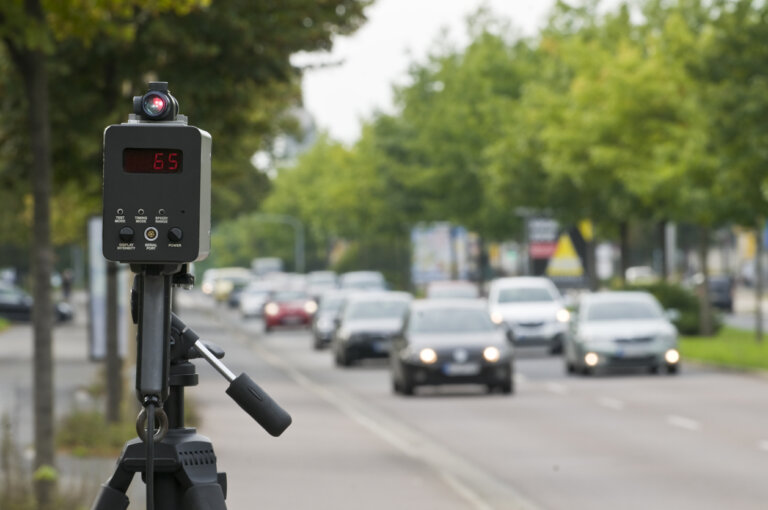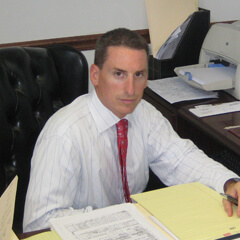Speed limits are set with the goal of keeping everyone safe. There is an inherent risk when driving a car. New York State Vehicle and Traffic Law (VTL) 1180-d simply states that a driver shall comply with posted maximum speed limits. Speeding tickets in New York State carry hefty fines, points, and can result in a suspended license. But can drivers go to jail for excessive speed in New York? Although it is unlikely, under VTL 1180 above, a judge can sentence someone to jail for 15 days for going 11 to 30 mph over the limit or 30 days for going 31+ mph over the limit. A second or third speeding offense in 18 months can result in 30 days in jail for going 11 mph or more over the limit. Michael A. Arbeit, P.C. can help you navigate should you receive a speeding ticket and could be facing serious consequences as a result of this ticket.
Most officers who issue radar speeding tickets in New York will typically testify that they first made a visual estimate of the speed of the vehicle and then confirmed that estimate with either a radar or laser unit. The prosecution must show that the particular radar unit the officer used was in proper working order. Usually, the officer testifies that they conducted an internal calibration test. This is generally done by the officer pushing a “test” button on the unit. If it is working properly a specific number will appear on the LED readout. The unit can also be tested by tapping a tuning fork provided by the manufacturer and holding it in front of the unit. If the unit is working properly it will display the speed the tuning fork is set for. The officer can also test the unit by having another vehicle drive through the radar beam at a known speed and see if the radar unit displays the correct speed.
What Does the Prosecution Need to Prove for a Speeding Charge?
When the prosecution asserts that a person has been speeding, they must demonstrate beyond a reasonable doubt that they are correct. If you are challenging a radar speeding ticket, one of your arguments might be that there was an inaccuracy in the radar device. This can be challenged in a number of ways, and there have been court cases that lend support to these types of challenges.
For example, if the police officer used a radar to catch someone speeding, then the following must be shown for a successful prosecution:
- The officer must have adequate training (minimal amount of hours) and experience in the operation of the Radar unit.
- The officer must testify as to how the unit was set up and the conditions the unit was operated under.
- It must be shown that the unit operated with a minimum possibility of distortion from external interference.
- As outlined above, the unit must be tested with an external source, such as a tuning fork(s) or an actual test run with another vehicle that has an accurately calibrated speedometer.
Common Defenses for Speeding Violations
An allegation of an inaccurate radar gun is a common defense in speeding violation cases. The New York Courts have made clear that these defenses are often unsuccessful, particularly when they seek to impose unnecessary requirements, such as proof of calibration records. Nevertheless, an experienced attorney will question the ticket officer’s recall of the events and can help to protect their clients from a conviction.
Other arguments that can be made to challenge a radar speeding ticket are as follows:
- Challenge Based on Speeding Out of Necessity – In the case of People v. Cataldo (1970), the defendant openly admitted to traveling at the higher rate of speed claimed by the officer but asserted that he traveled at that speed out of necessity, for he would have otherwise rear-ended a vehicle rapidly slowing down in in front of him. The court concluded Cataldo’s defense was appropriate, and he was found not guilty of the charge of speeding.
- Challenge Based on Failure to Identify the Driver – In the case of People v. Nicol (2002), Delores Nicol was issued a speeding ticket. The main point of contention at the trial was whether the prosecution could identify Delores as the operator of the vehicle.The court relied on the reasoning that while it is understandable that traffic police would not always recall the appearance of a person to whom they issued a ticket a few months before, they should be able at trial to definitively identify the driver either with the aid of notes from the time the ticket was issued, or relying entirely on such notes as evidence. Since no notes were provided as evidence, the court concluded that the prosecution had failed to prove Nicol was the driver of the vehicle. As a result, proof of her guilt was not found beyond a reasonable doubt.
- Challenges Based on Procedural Technicalities. Sometimes a challenge made based on a procedural technicality can lead to the dismissal of your case. For example, if untimely service of documents is provided to the defendant, or there is failure to inform the defendant of their right to an attorney at a trial.
Contact Michael A. Arbeit, P.C. Today for an Initial Consultation
An attorney’s knowledge of the documentary evidence needed to prevail in your case, procedures to be followed, capacity to shape the arguments, as well as to carve out exceptions to the law, can make all the difference in avoiding hefty fines, suspension of one’s license or a conviction. Also, remember that the standard the prosecution must prove in New York is beyond a reasonable doubt so the police officer has a higher burden than in some other states. This can also help if you have received a radar speeding violation. Michael A. Arbeit, P.C. can help you navigate the system and advocate for you to avoid the possible consequences of speeding tickets issued through radar systems.

